
Shikoku is the smallest of Japan’s four main islands. Its landscape a breathtaking mix of natural forest, beautiful coastline, mountains and unspoilt rivers, dotted with timeless villages and ancient temples. Are you an adventure seeker looking to explore beyond the tourist hotspots of Japan? With its traditional Japanese culture and some of the country’s most sublime scenery, Shikoku is the perfect lesser-visited destination.
For cyclists, Shikoku is perhaps most famous for the Shimanami Kaido – an impressive cycle highway of bridges and cycle paths that connect Shikoku to Japan’s main island, Honshu, across a series of small islands. The Shimanami Kaido is a big draw for Japanese and foreign tourists alike but to simply tick off this major landmark without exploring the rest of this spellbinding island would be a hugely missed opportunity to discover some of the best cycling, wild landscapes and hospitality Japan has to offer.
A brief history of Shikoku
Mountains and ancient onsens (hot springs)
Human habitation in Shikoku can be traced back to the Jomon period (14,000 – 300 BCE). The mountainous geography of Shikoku means it has historically been quite isolated, and this makes it a great place to see natural river valleys and traditional Japanese architecture. The island is, like many regions of Japan, home to numerous natural hot springs called onsens. It is believed that Dōgo Onsen in Matsuyama is the oldest in Japan’s known history, dating back almost 3000 years. The onsen was inspiration for Miyazaki’s animated classic Spirited Away.
Temples and pilgrimages
Undertaking an adventurous trip by bike can often feel like a pilgrimage – a journey of self-discovery or a desire to find meaning through learning about people and nature. On Shikoku you are not alone on your pilgrimage. The 1,200Km Shikoku Henro Pilgrimage route dates back to the 9th century. It’s an impressive 88 temple circuit associated with the Buddhist monk Kukai. Traditionally, the Shikoku pilgrimage is completed on foot and many thousands of people complete the route even today. Those undertaking it are easily recognisable in their white shirts and sedge hats.
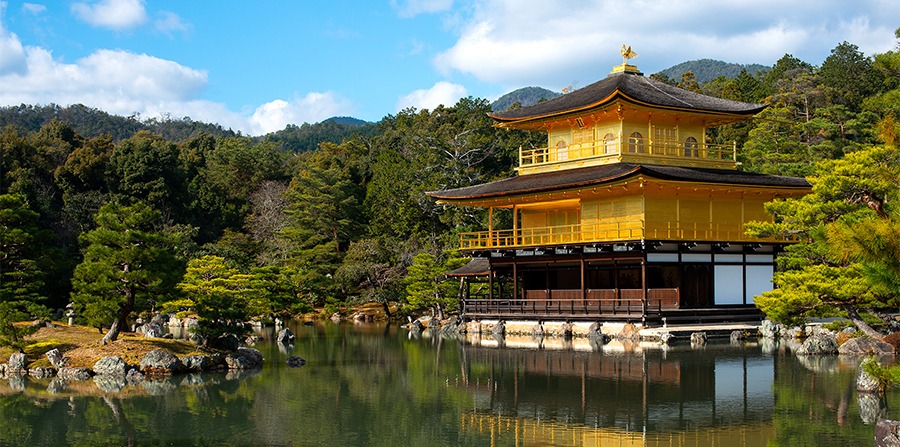
Castles and bridges
Shikoku has numerous historic castles that sit proud in its lush green landscape. In fact, of the 12 remaining castles from the Edo period across Japan, four of them can be found in Shikoku. These are Marugame, Matsuyama, Uwajima and Kōchi.
Shikoku is also home to several impressive vine bridges that link remote river valleys in the north of the island. Some believe the vine bridges were first constructed by Heike refugees fleeing the Genji clan in the 12th Century, as they could easily be cut, making the valley impassable. In fact, the remoteness of the deep valleys found in the Tokushima prefecture made them the perfect hideout for defeated samurai warriors and other refugees over the centuries.
From ancient vine bridges to modern-day architectural wonders, Shikoku is famed for its bridges. In 1985, the Great Naruto Bridge was completed, linking Shikoku to Honshu by road for the first time in history. This was followed by the Great Seto Bridge system in 1988, and the Nishiseto Expressway, otherwise known as the Shimanami Kaido in 1999.
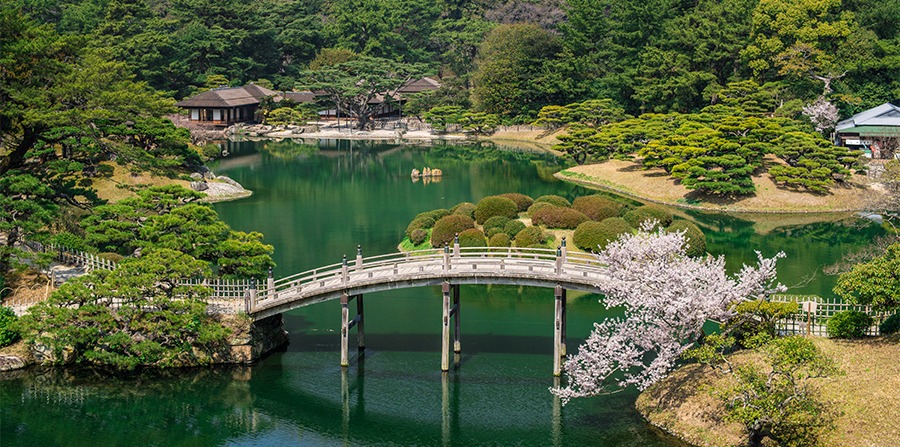
© Organisation For Promotion of Tourism In Shikoku
Highlights of cycling in Shikoku
Head to the south-eastern corner of the Kochi Prefecture and you’ll find one of Shikoku’s best kept secrets, the Shimanto River. This untouched river, free from dams and far away from major cities, is often called ‘the last pure river of Japan’. The river circles some 196Km through lush green forests. Quiet roads hug the riverside for much of its journey towards the Pacific Ocean, making it ideal to explore by bike.
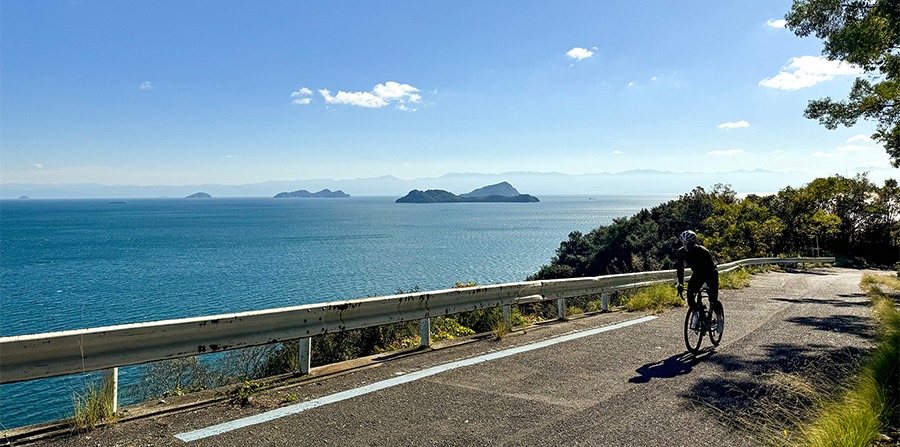
The Shimanto River is a contrast to the equally beautiful Tokushima Prefecture with its steep and mountainous terrain and impressive gorges, like the Oboke and Koboke gorges, and the remote Iya Valley. This region may have been a popular refuge for defeated warriors hundreds of years ago but even today, the most remote and narrow roads are a challenge for drivers and there are few cars, so you don’t have to cycle far to feel like you’ve uncovered a forgotten world. It is here that you’ll also find Shikoku’s second longest river, the Yoshino River. The river flows fast through the rocky valleys of Oboke Gorge, making it a popular spot to go white water rafting.
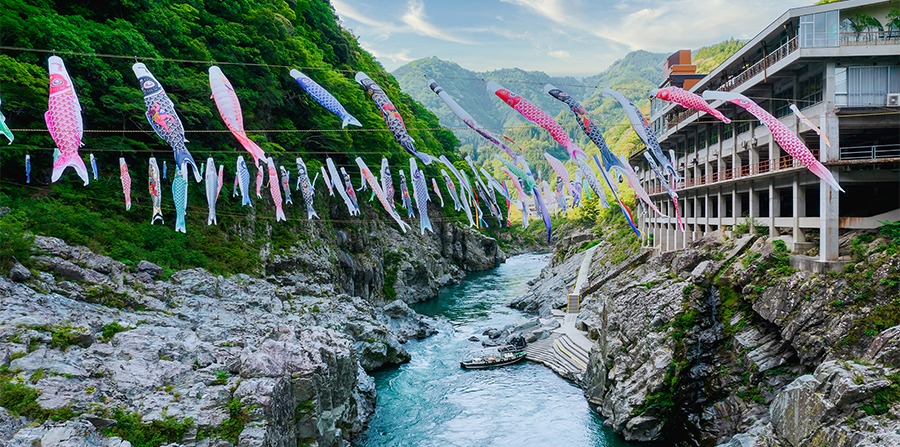
Oboke Gorge, Yoshino River and carp streamers, sightseeing spots in Miyoshi City, Tokushima Prefecture
Then there are the endless stretches of coastline and beaches. Ehime and Kochi prefectures boast numerous remote beaches and peninsulas that are perfect to reach by bike from its pleasant undulating coastal roads. Head to the southernmost point of Shikoku, Cape Ashizuri, and you’ll be treated to ocean vistas so vast that you can see the curvature of the earth.
Lastly, a must-experience cycling highlight of Shikoku is of course the famous Shimanami Kaido. The bridges that make up this ‘cycling superhighway’ offer up wonderful views across the islands and are every cyclists dream, with traffic-free smooth tarmac paths.

The best time of year for cycling in Shikoku
The best time of year to cycle on Shikoku is spring (late March to late May) and autumn (September to November). It’s best to avoid the rainy season and hot summer months, as well as the winter when many of the mountain passes are closed due to snow. In spring, Shikoku is awash with a colourful display of blooms, including the beautiful but short-lived sakura (cherry blossoms) which emerge from the end of March, and many other beautiful spring flowers that bloom after this. In autumn, you’ll be treated to a colourful display of orange and red hues across the island’s many forested hills and mountains.
Our Shikoku cycle route and terrain
Join us as we explore the road cycling paradise that is Shikoku! Over nine riding days, we’ll take you on a magical journey deep into the heart of this incredible island before spending a day cycling around the enchanting city of Kyoto.
Our Japanese road cycling adventure commences with two and a half days of island hopping as we explore the Seto islands which are connected by the Shimanami Kaido. After a transfer to Uwajima, we soon find ourselves on beautiful coastal and mountainous roads as we make our way south to Cape Ashizuri, the southernmost point of Shikoku.

From here, our Shikoku adventure takes us up and over winding roads until we reach the banks of the unspoilt Shimanto River. We then ride into beautiful forests in search of one of the Shimanto’s tributary rivers. As our journey continues upwards, we soon find the source of the Shimanto River, part way up Mt Irazu before we descend again into the city of Kochi.
The final days of our tour see us riding into the spectacular steep-sided valleys of the Oboke Gorge and Koboke Gorge, with time to stop and admire the 800 year old suspension bridges of the Iya Valley. After a rest day our journey continues east through the dramatic Iya Valley and the almost abandoned Nagoro ‘Village of Dolls’ where a local woman has made hundreds of scarecrows to represent those who have left. From here, we enjoy a long 22Km descent and make our way to the impressive city of Tokushima.
It is here that our Shikoku cycling tour ends but a transfer to Kyoto leaves us with a full day and a night to explore Japan’s ancient capital with a cycle tour around the city before we celebrate the end of our memorable road cycling adventure.
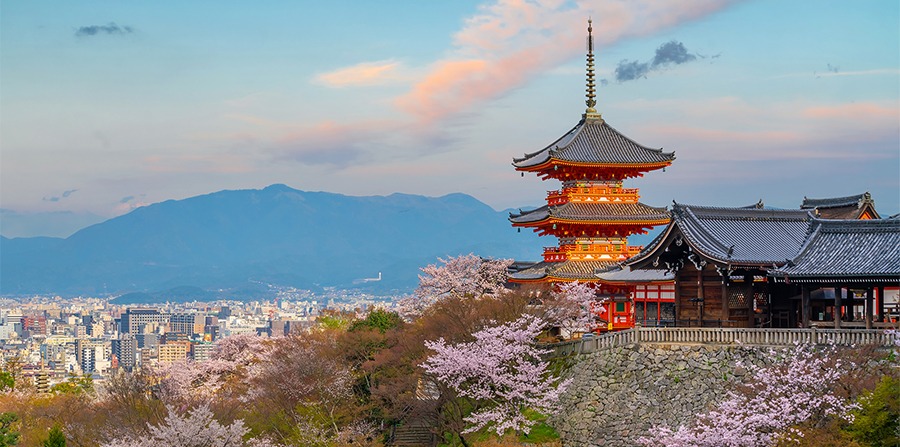
Join our road cycling holiday in Shikoku!
Of all the places we have cycled in Japan, Shikoku has to be one of the most beautiful. If you’re looking for a road cycling tour that balances beautiful riding with history, culture and mouthwatering cuisine, then Shikoku has it all. We’ve crafted an itinerary that makes the most of everything this island has to offer so join us and book onto one of our upcoming guided tours!
